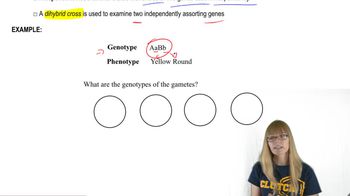Table of contents
- 1. Introduction to Genetics51m
- 2. Mendel's Laws of Inheritance3h 37m
- 3. Extensions to Mendelian Inheritance2h 41m
- 4. Genetic Mapping and Linkage2h 28m
- 5. Genetics of Bacteria and Viruses1h 21m
- 6. Chromosomal Variation1h 48m
- 7. DNA and Chromosome Structure56m
- 8. DNA Replication1h 10m
- 9. Mitosis and Meiosis1h 34m
- 10. Transcription1h 0m
- 11. Translation58m
- 12. Gene Regulation in Prokaryotes1h 19m
- 13. Gene Regulation in Eukaryotes44m
- 14. Genetic Control of Development44m
- 15. Genomes and Genomics1h 50m
- 16. Transposable Elements47m
- 17. Mutation, Repair, and Recombination1h 6m
- 18. Molecular Genetic Tools19m
- 19. Cancer Genetics29m
- 20. Quantitative Genetics1h 26m
- 21. Population Genetics50m
- 22. Evolutionary Genetics29m
3. Extensions to Mendelian Inheritance
Understanding Independent Assortment
Problem 3a
Textbook Question
A pure-breeding tall plant producing oval fruit as described in Problem 2 is crossed to a pure-breeding short plant producing round fruit.
If the F₁ identified in part (a) are crossed to one another, what proportion of the F₂ are expected to be short and produce round fruit? What proportion are expected to be tall and produce round fruit?
 Verified step by step guidance
Verified step by step guidance1
<span>Step 1: Identify the genotypes of the parent plants. Assume 'T' is the allele for tall plants and 't' is for short plants. Assume 'O' is the allele for oval fruit and 'o' is for round fruit. The pure-breeding tall plant with oval fruit would be 'TTOO', and the pure-breeding short plant with round fruit would be 'ttoo'.</span>
<span>Step 2: Determine the genotype of the F₁ generation. Cross the genotypes of the parent plants: 'TTOO' x 'ttoo'. The F₁ offspring will all be heterozygous 'TtOo'.</span>
<span>Step 3: Set up a Punnett square for the F₁ cross. Since the F₁ plants are 'TtOo', you will need a 4x4 Punnett square to account for all combinations of alleles: 'TO', 'To', 'tO', 'to'.</span>
<span>Step 4: Fill in the Punnett square to find the genotypes of the F₂ generation. Each cell in the Punnett square represents a possible genotype for the F₂ offspring.</span>
<span>Step 5: Calculate the proportions of the F₂ phenotypes. Count the number of 'ttoo' genotypes for short and round fruit, and 'T_oo' genotypes for tall and round fruit, and divide by the total number of offspring to find the expected proportions.</span>
Recommended similar problem, with video answer:
 Verified Solution
Verified SolutionThis video solution was recommended by our tutors as helpful for the problem above
Video duration:
3mPlay a video:
Was this helpful?
Key Concepts
Here are the essential concepts you must grasp in order to answer the question correctly.
Mendelian Genetics
Mendelian genetics is the study of how traits are inherited through generations, based on the principles established by Gregor Mendel. It involves understanding dominant and recessive alleles, where dominant traits mask the expression of recessive ones. In this scenario, the tall plant and round fruit traits are likely dominant, while short and oval traits are recessive.
Recommended video:
Guided course

Descriptive Genetics
Punnett Square
A Punnett square is a diagram used to predict the genotypes and phenotypes of offspring from a genetic cross. By organizing the alleles of the parent plants, it allows for a visual representation of the possible combinations in the F₂ generation. This tool is essential for determining the expected proportions of traits in the offspring.
Recommended video:
Guided course

Chi Square Analysis
Phenotypic Ratios
Phenotypic ratios refer to the relative frequencies of different phenotypes in the offspring resulting from a genetic cross. In this case, the expected proportions of short and round fruit plants can be calculated based on the genotypes derived from the F₁ generation. Understanding these ratios helps in predicting the traits of the F₂ generation accurately.
Recommended video:
Guided course

Mutations and Phenotypes

 4:58m
4:58mWatch next
Master Gamete Genetics and Independent Assortment with a bite sized video explanation from Kylia Goodner
Start learningRelated Videos
Related Practice


